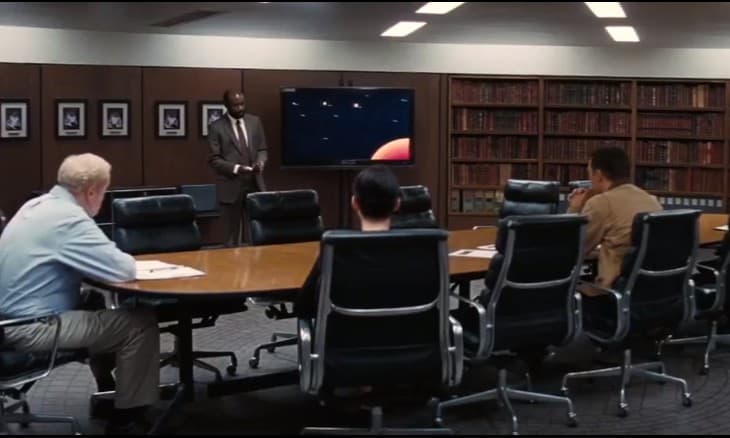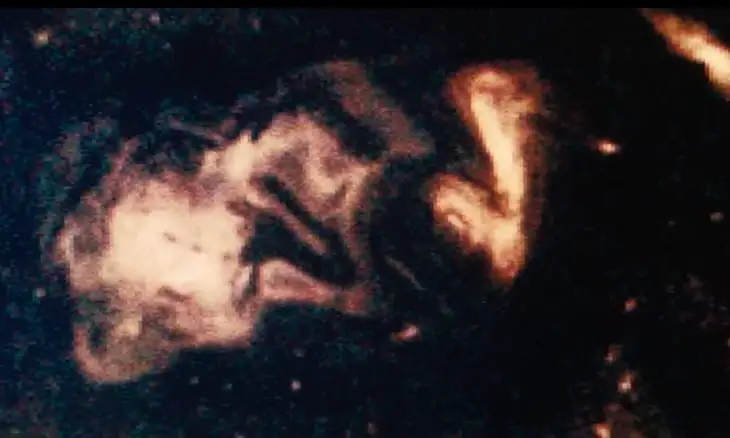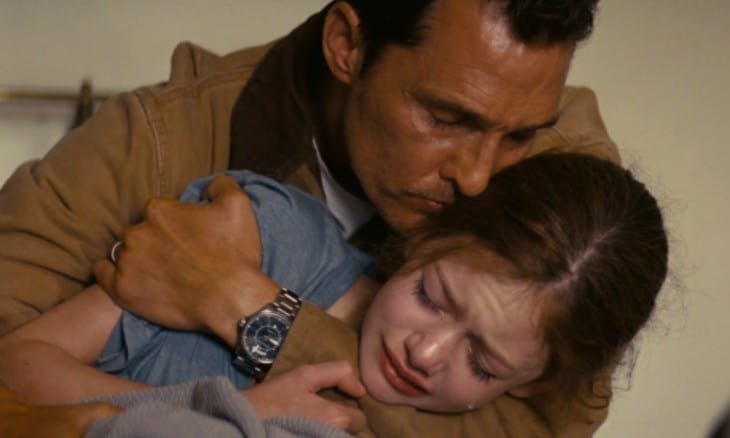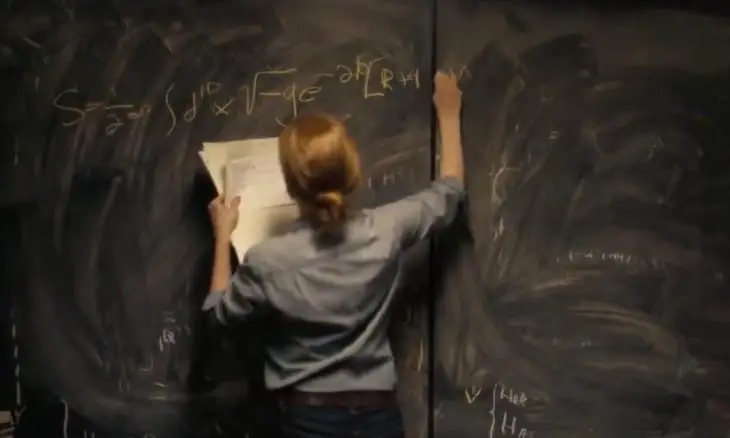The meaning of the film “Interstellar”
The American physicist Kip Thorne came up with the idea to make a film based on scientific theory. He also actively helped Christopher Nolan write the script for Interstellar, and he did it so well that even Stephen Hawking and Neil DeGrasse Tyson did not find any contradictions in the scientific component of the film. Later, Kip Thorne wrote a book in which he explained the physical and astronomical basis of Interstellar. Our book was published in 2015 under the title “Interstellar: Science Behind the Scenes” by the publishing house “Mann, Ivanov and Ferber”.
Not all of us, however, have Hawking’s baggage of knowledge, there may not be time for a book, but we want to understand the meaning of the movie “Interstellar”. In this article I will try to answer those questions that you might have while watching.
In what century does the film take place?
Interstellar begins with pictures of total hunger and devastation on Earth. An unknown disease affects one after another useful cereals: wheat has already died out, corn is next. In what year the catastrophe began and what century it is now – we will never know. You can, however, speculate.
During a baseball game, Cooper’s father-in-law, Donald, states that “in his time” people knew how to play baseball, but now it’s a pity to look at the players. Cooper counters this: “In my day, people were too busy getting food to play baseball.” Cooper is now about 40; from his words, we can conclude that drought and famine began during his youth, that is, 20-30 years ago. Generation Donald still found the world healthy and well-fed. At the same time, the world of “Interstellar” is too similar to ours with you to relate the events of the film to the distant future. Most likely, the action takes place at the end of the 21st century, but this is just a guess. But we know for certain what real events Nolan was inspired by.
The Dust Cauldron is the name given to the devastating dust storms that swept across the prairies of the United States and Canada in 1930-1940. If you have read John Steinbeck’s novel “The Grapes of Wrath”, then you probably remember these terrible pictures of hunger and poverty – Steinbeck wrote about the events of the Dust Cauldron. American farmers improperly cultivated their fields and dried out the soil; this coincided with a long absence of rain. As a result, dust storms rained down on farmers’ fields and homes, blowing away the topsoil, leading to hunger and disease, and forcing several million people to flee their homes. Remember the old people talking about drought, dust and hunger from screens in Cooper’s new home? Some of these shots Nolan borrowed from the documentary about the Dust Cauldron.

What is a wormhole and who created it?
Professor Brand explains to Cooper that the only way out for humans is to flee Earth and establish a colony on a new planet suitable for life. Since no such planets have been found in the solar system, you need to get out of it – to another star. Here we come to the meaning of the title of the film: Interstellar means “interstellar”. People are faced with the task of flying from one star (the Sun) to another, but they do not have enough technical capabilities for this. Human life and fuel supplies will not be enough to get to the new solar system.
Travel to another star becomes possible when scientists discover a wormhole (wormhole) near Saturn. A wormhole is a gravitational anomaly that allows astronauts to quickly move from the solar system to a distant part of the universe. A wormhole or wormhole is a real-life concept in science that grew out of Einstein’s general theory of relativity. Romilly demonstrates to Cooper how a wormhole works by folding a piece of paper; you can see the same model in the wormhole section of Wikipedia.

Professor Brand says wormholes do not appear by themselves; Kip Thorne confirms this claim in his book. The heroes of the film decide that the wormhole was created by some “they” – a more developed form of life that exists in five dimensions. But in the end it turns out that “they” are the humanity of the future. It turns out that the people of the future built this bridge in the form of a wormhole for the people of the past – so that they could escape and build this very future civilization.

Why does time pass at different speeds on different planets?
One hour on Miller’s planet is equal to seven Earth years – and Cooper does not forget about it for a minute, while his comrades wander knee-deep in water in search of the wreckage of the ship. The heroes explain: time on Miller’s planet goes faster due to the fact that it is located very close to a black hole called Gargantua. Not the most comprehensive explanation, to be honest.
According to Einstein’s general theory of relativity, massive objects cause space-time to bend. It’s like putting a ball on top of a stretched canvas: the ball is heavy, so it will push the canvas a little. Planets and black holes push through the canvas of space-time around them. This is already a proven fact: for example, in 2004, the Gravity Probe B satellite collected data that confirmed that space-time around the Earth is curved. Gargantua’s black hole is much more massive than Earth, so the curvature of space-time around it is incomparably greater. This makes time run faster on Miller’s planet.

Where does Cooper go from the black hole?
In the script of the film, this strange place is called the “tesseract”. In general, a tesseract is a geometric figure, a four-dimensional version of a cube. That is, a tesseract in relation to a cube is the same as a cube in relation to a square. In Interstellar, a tesseract is a three-dimensional model of four-dimensional space that the people of the future built specifically for Cooper.
Unclear? I’ll explain now. Let’s remember the words of Amelia Brand: “For ‘them’, time can be a physical dimension … And the future is a mountain that ‘they’ can climb.” “They,” as we remember, are people from the future. “They” have learned to move freely in time as well as in space. Cooper does not have this ability, but inside the tesseract, he can move between different time points. Now for him, time has become a physical dimension.
It is important to understand here that physically Cooper cannot travel to the past. The only force that freely penetrates from his time into the past is gravity. This is what Cooper uses to convey information to himself and Murph in the past.

How did Murph save humanity?
Professor Brand Sr. from the very beginning understands that the Earth can no longer be saved, you need to flee from it. He also knows that it is impossible to get all the people off Earth: there will not be enough rocket power. Therefore, he is looking for the key to solving this problem in gravity. But before dying, he confesses to Murph that the equation has long been solved, and he never learned how to control gravity.
Murph continues to look for a solution to the problem and finds it on the hand of the clock: the data that her father gave her turns out to be the missing link in the equation. But the film does not show how exactly Murph managed to evacuate all the people from the dying planet. Murph’s decision is explained in his book by Kip Thorne. According to him, Murph figured out how to reduce the force of gravity on Earth. This made it easier to launch rockets full of people into space. True, the violation of the Earth’s gravitational field also led to even greater disasters like earthquakes and tsunamis, but for people now it does not matter.
Station Cooper, where father and daughter meet in the finale, is not the only one – it must be assumed that by this time all of humanity has lived at several similar stations and is preparing to move to Edmunds’ planet.
What is the meaning of Interstellar?
We figured out the theoretical questions, but Interstellar is still a feature film, not a popular science film. So, there is some idea that Nolan wanted to convey to us, in addition to important discoveries in physics and astronomy over the past hundred years. To understand this idea, it is necessary to analyze two key themes of the film – love and the desire for knowledge.

Power of love
All heroes who contribute to the salvation of humanity do it for the sake of love. Amelia wants to see Edmunds – in the finale it turns out that it was his planet that turned out to be the only one suitable for life. Cooper loves his daughter and for the sake of her salvation is ready to dive into a black hole – and so he manages to transfer the most valuable data for scientists to Earth. Murph, in turn, loves his father and returns to his room many years later to collect his gift – a watch. And the clock turns out to be encrypted information that will save people on Earth.
“I am drawn across the entire universe to a person whom I have not seen for ten years, and who may already be dead. Love is the only feeling available to us that can go beyond time and space ”
These words – Amelia Brand’s monologue – are, in my opinion, key to understanding the theme of love. Love is the main driving force in the film, but not only for other people. There is also a love of knowledge.

Craving for knowledge
All the heroes of Interstellar are very clearly divided into two camps. In the first – people making every effort to solve the problem, not ready to give up, striving to discover new things. This is Murph and the entire crew of the spaceship Endurance: Cooper, Amelia, Romilly and Doyle. The craving for knowledge is most clearly manifested, of course, by Cooper and Murph. Cooper, even after becoming a farmer, cannot forget the knowledge that he possessed earlier. He insists that his son get an education. He seeks to the last a way to save Murph and the rest of the people on Earth. Murph continues to work on Plan A, even after hearing from Brenda that it is not feasible. She tries to save her brother’s family from disaster, although he opposes her.
In the second camp there are opponents of knowledge and simply inert people, content with their lot. This is Tom, Cooper’s son, who enjoys being a farmer. This is Cooper’s father-in-law Donald. The most mischievous characters here are the teachers at the Cooper’s kids’ school. They teach false knowledge that will only prevent children from surviving.
According to the plot, Professor Brand Sr. and Dr. Mann move from the first camp to the second. Their original goal was to save humanity, and they have made a great contribution to the solution of this task. But later, both dropped their hands: Brand was disappointed in his equation, and Mann simply went crazy on a deserted planet.
The meaning of the film “Interstellar”, if reduced to one sentence, is extremely simple: knowledge and the search for new things are good, limitations and inaction are bad. The lives of millions of people depend on the likes of Murph and Cooper, who are willing to solve a problem to the end and take risks to solve it.
Knowledge alone is not enough: without love, it does not bring good. We know that Dr. Mann has no family and friends left on Earth, and therefore the fate of humanity does not bother him, his own life is more expensive. Professor Brand Sr., on the one hand, provides his daughter with a relatively good fate: she has a real chance to survive, while those remaining on Earth, in accordance with his plan, will inevitably perish. But on the other hand, he hides his plan from her, and this makes her an unwitting accomplice in his father’s crime. Brenda’s love for Amelia is not as strong as Cooper’s love for Murph, so Cooper and Murph become the saviors of humanity, not Professor Brand.







